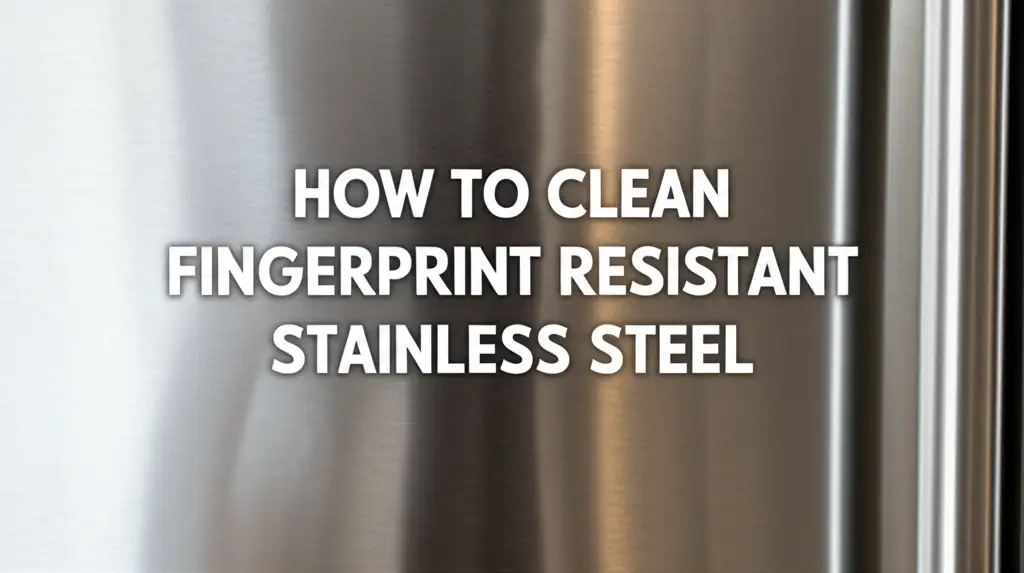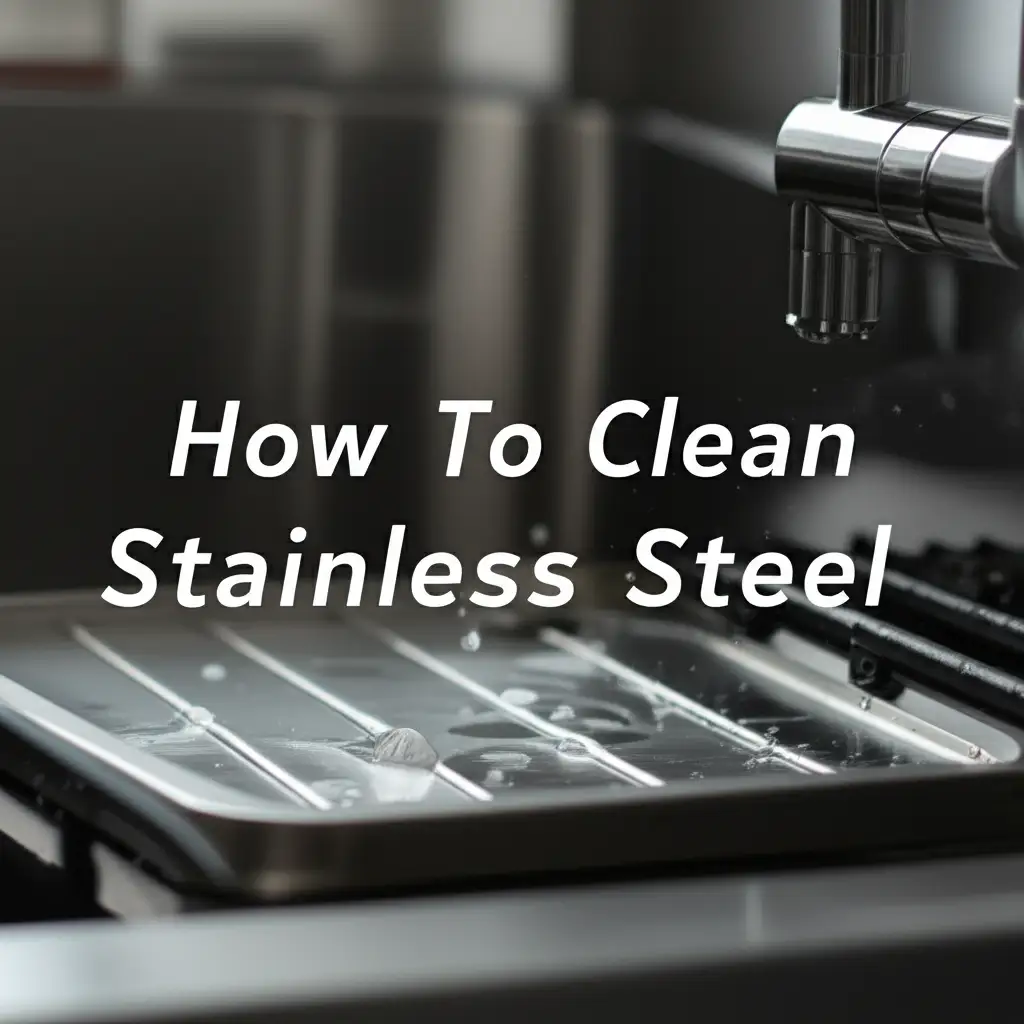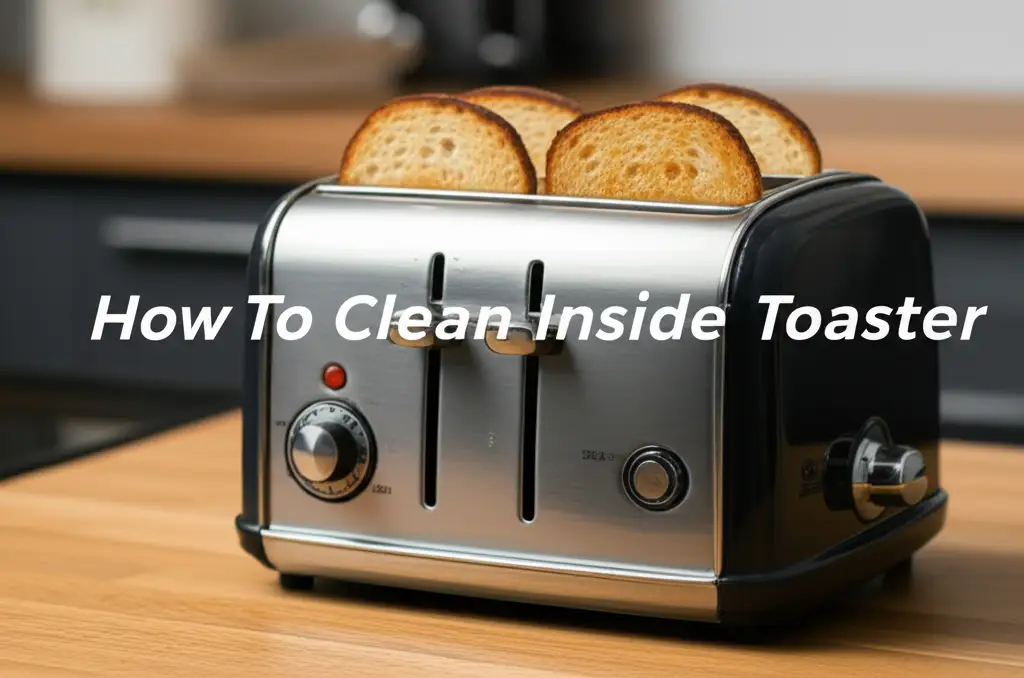· Home Cleaning · 16 min read
How To Clean Fingerprint Resistant Stainless Steel

Cleaning Fingerprint Resistant Stainless Steel Appliances
Your home shines with the sleek look of stainless steel appliances. Many modern kitchens feature beautiful, durable stainless steel surfaces. However, traditional stainless steel often shows every touch. Fingerprint resistant stainless steel solves this problem. It looks great, but still needs proper care to keep it looking its best. Knowing how to clean fingerprint resistant stainless steel ensures your appliances stay pristine.
This comprehensive guide will help you understand your fingerprint resistant surfaces. We will cover the best tools and cleaners. You will learn daily cleaning routines and tips for tackling stubborn marks. We also discuss natural cleaning methods and common mistakes to avoid. My goal is to help you maintain your beautiful, smudge-proof kitchen.
Takeaway
Keeping your fingerprint resistant stainless steel spotless is simple with the right approach:
- Use microfiber cloths and gentle cleaners.
- Always wipe in the direction of the grain.
- Avoid abrasive materials and harsh chemicals.
- Perform daily light cleaning and occasional deep cleaning.
- Maintain the protective coating for lasting shine.
How do you clean fingerprint resistant stainless steel?
Clean fingerprint resistant stainless steel by wiping gently with a soft microfiber cloth dampened with warm water or a specialized stainless steel cleaner. Always follow the grain of the metal to avoid streaks. Dry immediately with a second clean, dry microfiber cloth for a spotless, streak-free finish.
Understanding Fingerprint Resistant Stainless Steel
Fingerprint resistant stainless steel is a popular choice for appliances. It offers the classic look of stainless steel without the constant smudges. This type of steel has a special clear coating. This coating reduces the visibility of fingerprints and smears. It makes your daily cleaning routine much easier.
Traditional stainless steel shows every touch. Oils from your skin leave obvious marks. Fingerprint resistant versions have a repellent layer. This layer prevents oils from sticking and spreading. It makes marks less noticeable and much easier to wipe away. This innovation has made stainless steel more practical for busy households.
The protective coating is usually a clear polymer. This polymer bond adheres to the stainless steel surface. It creates a smooth, non-porous barrier. This barrier repels water and oils. It also helps protect against minor scratches. Understanding this coating is key to cleaning it correctly. You must use gentle methods to preserve this valuable layer.
Many modern refrigerators, dishwashers, and ovens now use this technology. Manufacturers like Samsung, LG, Whirlpool, and GE offer appliances with this finish. They want to give consumers beauty without the maintenance headache. This coating also helps maintain the appliance’s appearance over time. It keeps your kitchen looking new.
This finish is not completely “fingerprint proof.” It resists fingerprints, but does not eliminate them entirely. Some marks may still appear, especially with heavy use. The difference is how easily these marks disappear. A quick wipe usually restores the surface. This makes it a great choice for families.
Essential Tools and Cleaners for Fingerprint Resistant Surfaces
Cleaning your fingerprint resistant stainless steel requires specific tools. Using the right items protects the special coating. It also ensures a streak-free shine. I always recommend having these essentials on hand. They make the job simple and effective.
First, you need high-quality microfiber cloths. These cloths are soft and absorbent. They will not scratch the surface of your appliances. Avoid paper towels or rough sponges. These can leave lint or tiny scratches. I use several microfiber cloths: one for washing, one for drying.
Next, choose your cleaning solution carefully. For light cleaning, warm water is often enough. For more stubborn marks, a mild dish soap solution works well. Mix a few drops of dish soap with warm water. You can also use specialized stainless steel cleaners. Make sure they specify “fingerprint resistant” or “for all stainless steel finishes.”
Avoid harsh chemicals at all costs. Bleach, ammonia, and abrasive cleaners can damage the protective coating. They can also leave permanent streaks or discoloration. Stay away from steel wool, scouring pads, and scrub brushes. These items will scratch the surface. They can also remove the fingerprint resistant layer.
Some natural options are also very effective. White vinegar diluted with water is a great degreaser. Baking soda can tackle specific stains. However, use these with caution on fingerprint resistant surfaces. Always dilute vinegar properly. Create a paste with baking soda for specific spots. Ensure thorough rinsing to avoid residue.
You might also consider a stainless steel polish. After cleaning, a polish can enhance the shine. It also adds a layer of protection. Many polishes are oil-based. They help repel new fingerprints and smudges. Apply these sparingly with a clean microfiber cloth. Buff gently for a brilliant finish.
Daily Cleaning for Fingerprint Resistant Appliances
Regular cleaning keeps your fingerprint resistant stainless steel looking new. Daily maintenance is easy and prevents buildup. It helps preserve the special coating. I find that a quick wipe-down each day makes a big difference. It avoids the need for heavy scrubbing later.
Start with a clean, soft microfiber cloth. Dampen it slightly with warm water. You do not need much water. Excess moisture can leave water spots. Wipe the surface gently. Always follow the grain of the stainless steel. Wiping against the grain can create streaks. It might also push dirt into the tiny grooves.
For visible smudges or light spills, warm water is often sufficient. The fingerprint resistant coating makes dirt slide off easily. If you see fingerprints, a quick wipe typically makes them disappear. This daily habit prevents oils and dirt from settling on the surface. It preserves the clean look.
After wiping, immediately dry the surface. Use a second, clean, dry microfiber cloth. Drying is important to prevent water spots. Water spots are tiny mineral deposits left behind when water evaporates. Buff the surface gently until it looks completely dry and streak-free. This simple step gives you the best results.
If you have light grease splatters or food residue, a tiny bit of mild dish soap can help. Add one or two drops of dish soap to your warm water. Dip your microfiber cloth into this solution. Wring it out well. Wipe the affected area following the grain. Then, rinse with a clean, damp cloth. Dry immediately.
This daily routine takes only a few minutes. It keeps your stainless steel looking its best without much effort. Consistent care prolongs the life of the fingerprint resistant coating. It also reduces the need for deeper cleaning. I highly recommend making this a part of your kitchen cleanup routine.
Tackling Stubborn Stains and Marks
Even with fingerprint resistant stainless steel, some stubborn marks can appear. Grease, food spills, or hard water spots might need more attention. Do not worry. You can remove these stains without damaging the finish. The key is to use the right approach and gentle cleaners.
For greasy marks or food residue, mild dish soap is your best friend. Mix a small amount of liquid dish soap with warm water. Dip a clean microfiber cloth into the solution. Wring it out so it is damp, not soaking wet. Gently wipe the greasy area. Always go with the grain of the stainless steel. This helps lift the grease effectively. For really tough grease, you might need to apply a little more pressure. You can also try a specialized cleaner for this. If you have a problem with general grease buildup on stainless steel, read more about how to clean grease off stainless steel.
Hard water stains are another common issue, especially around water dispensers. These look like cloudy or white spots. For these, a vinegar solution works well. Mix equal parts white vinegar and water in a spray bottle. Spray lightly onto the hard water spots. Let it sit for a minute or two. Then, wipe away with a clean microfiber cloth, following the grain. Rinse with plain water and dry thoroughly. For specific problems with hard water, learn how to clean hard water stains from stainless steel sink.
Sometimes, you might get general stains that are not clearly grease or water. For these, consider a dedicated stainless steel cleaner. Read the label carefully to ensure it is safe for fingerprint resistant finishes. Apply the cleaner directly onto a microfiber cloth, not directly onto the appliance. Wipe the stain gently. These cleaners often contain mild solvents and polishes that lift dirt and leave a shine. They also protect the finish.
Always remember to rinse and dry the area after treating any stain. Rinsing removes any cleaning product residue. Drying prevents new water spots and streaks. Using a separate dry cloth for buffing gives the best results. Patience and gentle technique are crucial here. Avoid scrubbing hard. That can harm the protective layer. For all types of stains, understanding how to clean stains on stainless steel can provide further help.
Natural Cleaning Solutions for Stainless Steel
Many people prefer natural cleaning methods. They are safe for your home and the environment. You can effectively clean fingerprint resistant stainless steel using common household items. Vinegar and baking soda are excellent choices. They tackle many types of dirt and stains. I often use these for my own cleaning needs.
White vinegar is a powerful natural cleaner. It cuts through grease and dissolves mineral deposits. For general cleaning, mix equal parts white vinegar and warm water in a spray bottle. Spray this solution onto a clean microfiber cloth. Wipe the stainless steel surface following its grain. The acidity of vinegar helps remove grime without harsh chemicals. This is particularly effective on water spots or light grease. For more information on using vinegar for cleaning, check out our guide on how to clean stainless steel appliances with vinegar.
After using the vinegar solution, always rinse the surface with plain water. Use a clean, damp cloth for rinsing. Then, dry immediately with another clean, dry microfiber cloth. This prevents any vinegar smell from lingering. It also ensures no streaks are left behind. Vinegar dries quickly, so quick buffing is important.
Baking soda is another versatile natural cleaner. It acts as a mild abrasive, perfect for specific, tougher spots. To use baking soda, create a paste. Mix a small amount of baking soda with just enough water to form a thick paste. Apply this paste directly onto a stubborn stain. Let it sit for about five to ten minutes.
Gently rub the paste over the stain using a soft microfiber cloth. Make sure to rub in the direction of the stainless steel grain. The gentle abrasive action of baking soda helps lift stuck-on food or grime. Do not scrub hard. After removing the stain, wipe away all baking soda residue with a clean, damp cloth. Then, dry the surface thoroughly. Using baking soda, alone or with vinegar, can solve many cleaning problems. You can explore more about how to clean with vinegar and baking soda for general cleaning applications.
These natural solutions are gentle on your fingerprint resistant coating. They are also economical. Always test any new cleaning method on an inconspicuous area first. This ensures it does not harm your specific appliance finish. Using these natural options keeps your appliances shining without harsh chemicals.
Common Cleaning Mistakes to Avoid
Cleaning fingerprint resistant stainless steel seems simple. However, some common mistakes can damage the finish. Avoiding these errors ensures your appliances stay looking great. I want you to protect your investment. Knowing what not to do is as important as knowing what to do.
First, never use abrasive cleaners or scrubbers. This includes steel wool pads, scouring sponges, or powdered cleansers. These products can scratch the delicate protective coating on your fingerprint resistant stainless steel. Once scratched, the surface will lose its smudge-resistant properties. It will also become more prone to showing marks. Always stick to soft microfiber cloths.
Second, avoid harsh chemical cleaners. Bleach, ammonia-based cleaners, oven cleaners, and cleaners containing chlorine are extremely damaging. They can strip away the clear protective layer. This exposes the underlying stainless steel. The steel then becomes vulnerable to fingerprints, stains, and even rust. Always read product labels carefully. Choose cleaners specifically labeled safe for stainless steel or “all stainless steel finishes.”
Third, do not wipe against the grain of the stainless steel. Stainless steel has a visible grain, like wood. Wiping across it can trap dirt in the tiny grooves. It can also leave unsightly streaks. Always wipe in the direction of the grain. This method cleans more effectively and leaves a smoother, streak-free finish. Take a moment to identify the grain before you start cleaning.
Fourth, do not let cleaning solutions dry on the surface. Water spots and streaks occur when liquids evaporate. Always wipe down the surface thoroughly with a dry cloth immediately after cleaning. This step is crucial for achieving a spotless shine. Leaving cleaners to air dry can also leave residue that attracts more dirt.
Fifth, do not use excessive amounts of cleaner. A little goes a long way, especially with specialized stainless steel cleaners. Too much product can leave a film or residue. This residue can be difficult to remove. It also might attract more dust and fingerprints. Apply cleaners to your cloth first, then wipe the surface.
Finally, do not forget to clean regularly. Allowing dirt, grease, and fingerprints to build up makes cleaning harder. It also forces you to use more aggressive methods. Daily or every-other-day light wiping keeps your appliances looking fresh. This prevents the need for intense cleaning sessions. Consistent, gentle care is the key to maintaining your fingerprint resistant stainless steel.
Maintaining the Protective Coating
The fingerprint resistant coating is what makes your stainless steel special. Proper maintenance helps this coating last longer. This ensures your appliances continue to resist smudges and look beautiful. I believe proactive care is always better than reactive cleaning.
After cleaning, consider using a specialized stainless steel polish. Many polishes are designed to not only shine but also protect. They often contain light oils or silicone. These create an invisible barrier on the surface. This barrier helps repel new fingerprints and smudges. It also enhances the natural luster of the steel. Make sure the polish is safe for “fingerprint resistant” or “coated” stainless steel. Some polishes are made for traditional stainless steel only.
When applying polish, use a clean, dry microfiber cloth. Apply a small amount of polish to the cloth, not directly to the appliance. Wipe in the direction of the grain. Use light, even strokes. You do not need much polish. A thin, even coat is all you need. Over-applying can leave a greasy residue.
After applying, use a separate, clean, dry microfiber cloth to buff the surface. Buff until no streaks or residue remain. This step is vital for achieving a truly spotless and brilliant shine. Buffing also helps distribute the protective layer evenly. It makes the surface smooth and sleek.
Avoid scratching the surface at all costs. Tiny scratches can compromise the protective coating. This makes those areas vulnerable to fingerprints. Be careful with sharp objects near your appliances. Keep abrasive materials away from the surface. Even gentle rubbing with a dirty cloth can cause micro-scratches.
Regular, gentle cleaning helps preserve the coating’s integrity. Dust and grime can slowly degrade the finish over time. Wiping daily prevents this buildup. It removes abrasive particles before they can cause damage. Think of it as a protective shield that you are maintaining.
Consider the environment around your appliances. High humidity or exposure to harsh chemicals can also affect the coating. Ensure good ventilation in your kitchen. Clean up spills promptly. These small actions contribute to the long-term health of your appliance’s finish. Proper care means your fingerprint resistant stainless steel will continue to be a star in your kitchen.
FAQs About Cleaning Fingerprint Resistant Stainless Steel
Can I use Windex or glass cleaner on fingerprint resistant stainless steel?
I do not recommend using Windex or other glass cleaners. These products often contain ammonia, which can damage the special protective coating on fingerprint resistant stainless steel. Using them can lead to streaks or even strip the anti-fingerprint layer over time. Stick to water, mild dish soap, or specific stainless steel cleaners for best results.
How often should I clean my fingerprint resistant stainless steel appliances?
For best results, I suggest a light daily wipe-down. This removes surface dust and minor smudges before they build up. A deeper cleaning, with a mild soap solution or specialized cleaner, can be done once a week or as needed. Consistent, gentle care prevents stubborn marks.
Will a regular stainless steel cleaner work on fingerprint resistant surfaces?
Many regular stainless steel cleaners are safe, but always check the label. Some specific formulas might be too harsh or leave a residue on the protective coating. Look for cleaners explicitly stating they are safe for “all stainless steel finishes” or “coated stainless steel” to ensure compatibility and avoid damage.
What causes streaks on fingerprint resistant stainless steel after cleaning?
Streaks usually happen for a few reasons. Too much cleaner, not wiping in the direction of the grain, or not drying the surface immediately are common causes. Always use a minimal amount of product, follow the grain, and buff dry with a clean, separate microfiber cloth for a streak-free finish.
Can I remove scratches from fingerprint resistant stainless steel?
Unfortunately, deep scratches cannot be easily removed from fingerprint resistant stainless steel without professional help. The protective coating makes repairs difficult. Preventing scratches is key. Avoid abrasive materials and sharp objects near the surface to maintain its pristine look.
Is olive oil a good way to polish fingerprint resistant stainless steel?
While some people use olive oil on traditional stainless steel, I do not recommend it for fingerprint resistant surfaces. The oil can leave a greasy residue that attracts dust and might compromise the protective coating. Stick to specialized stainless steel polishes designed for these finishes for a clean, streak-free shine.
Conclusion
Keeping your fingerprint resistant stainless steel appliances clean is simple with the right approach. You now understand what makes this material special. You know the best tools and cleaners to use. Remember, the key is gentleness and consistency. Daily light cleaning and occasional deeper treatment will maintain its beautiful, smudge-proof finish.
Always use soft microfiber cloths. Choose mild cleaners like warm water or diluted dish soap. Wipe in the direction of the grain. Avoid harsh chemicals and abrasive scrubbers. These can damage the protective coating. Following these tips ensures your fingerprint resistant stainless steel stays spotless. You will enjoy a gleaming kitchen without constant worry about fingerprints. Embrace these simple habits. Your appliances will thank you by shining brilliantly for years to come.
- stainless steel cleaning
- fingerprint resistant
- appliance care
- kitchen cleaning
- smudge-proof




